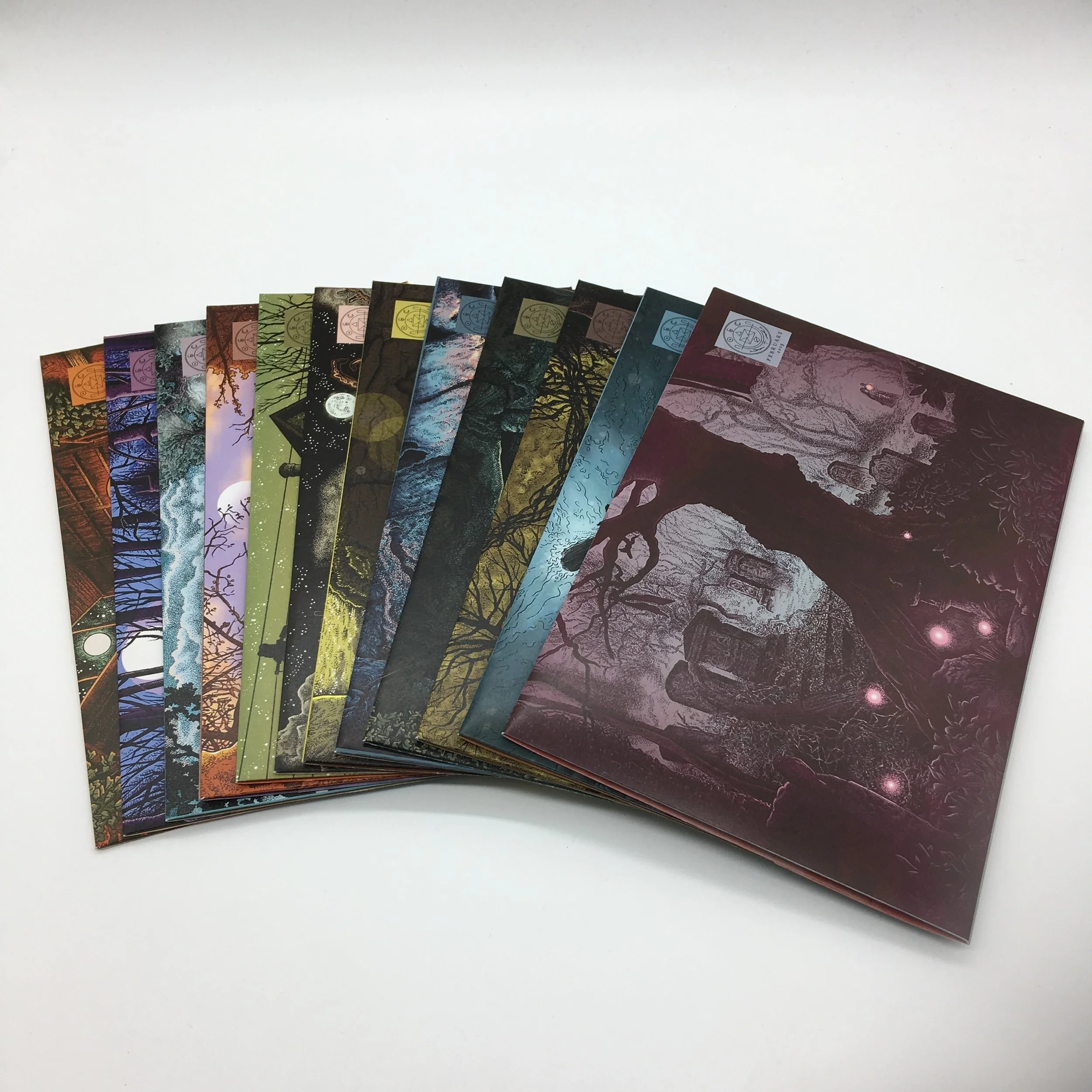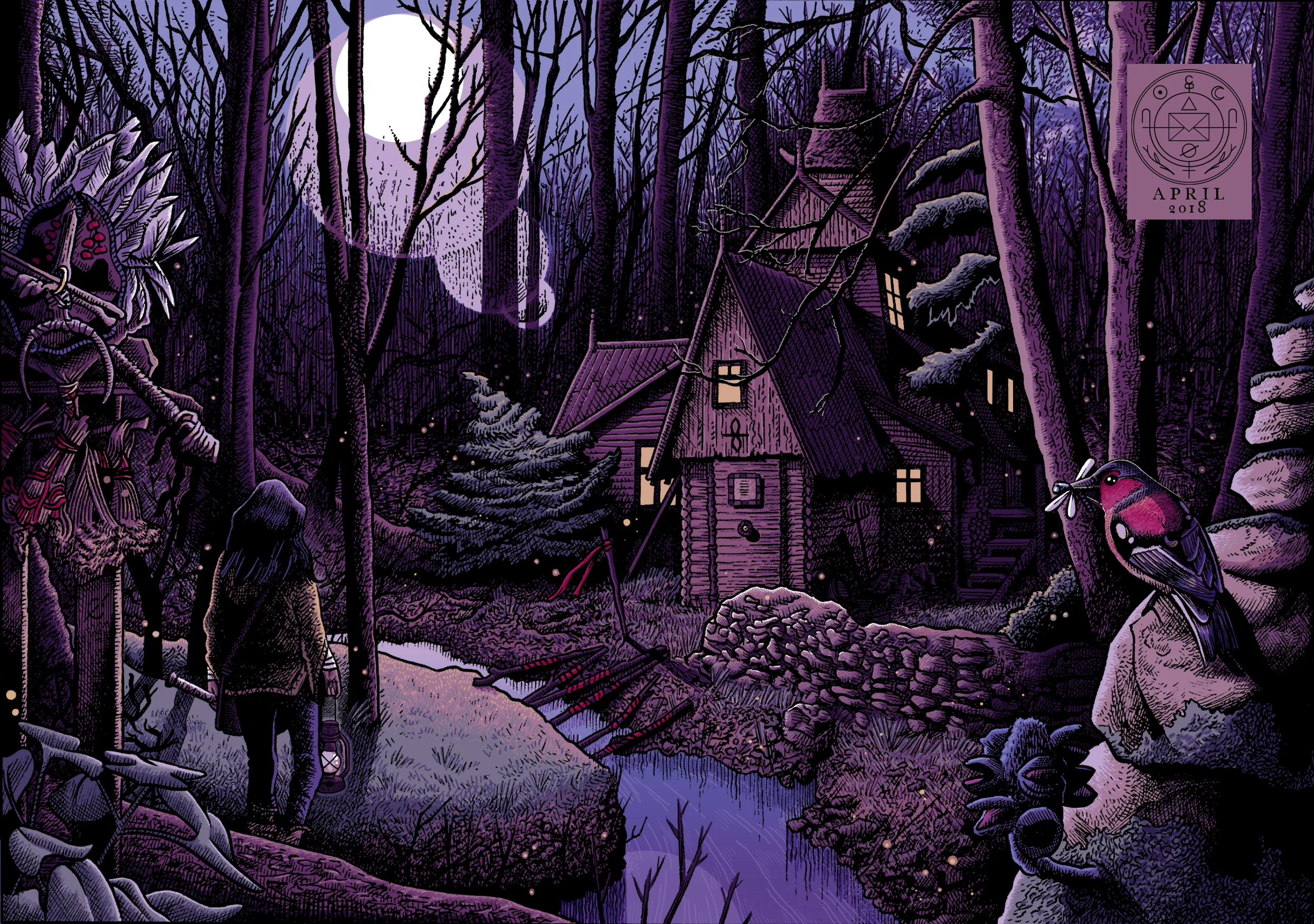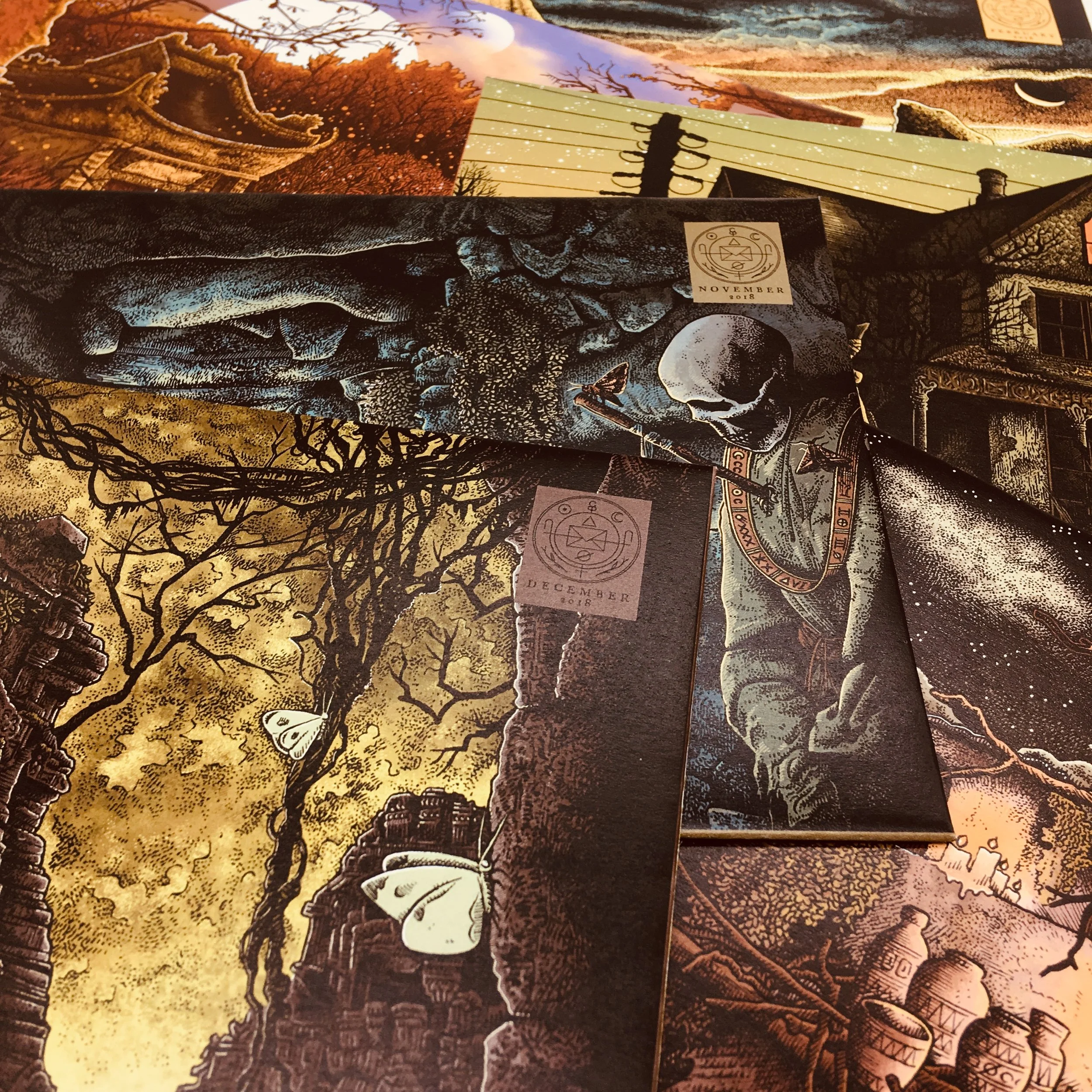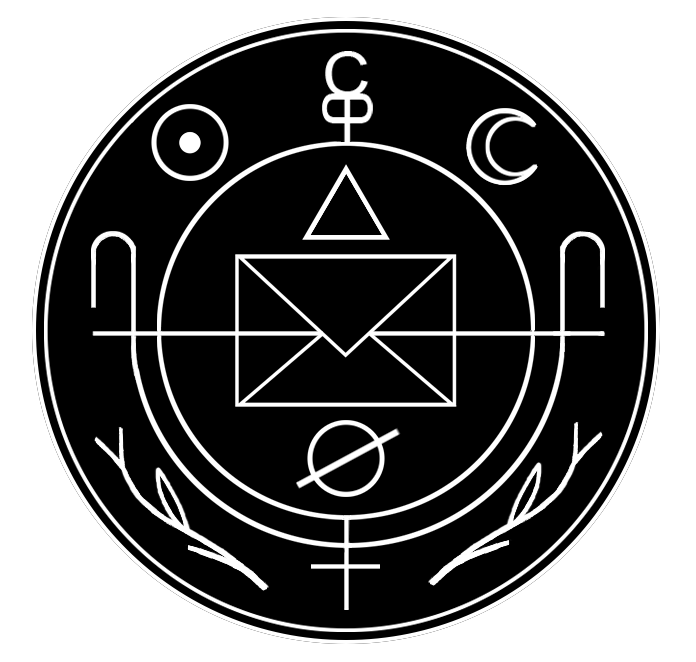What’s a Cryptogram Puzzle Post?
An Autobiographical Essay on Comics, Symbolism, Magic & Game Mechanics
by Jack Fallows
Back in March 2017, I began easily my most ambitious self-publishing project to date – Cryptogram Puzzle Post. The main barrier I’ve faced in terms of marketing this project so far is that it isn’t easily summed up in a sentence. But this is also what I find most infectious about it from a creative perspective. For now, I’ve been describing it as ‘a monthly illustrated puzzle story’.
But I wanted to get into the real guts of it here because although it may seem as though it’s sprung out of left field to anyone who followed my creative work before the project began, it’s actually been a natural, even inevitable, distillation of all the things I find fascinating as an artist and maker. And I want to define the links and interplay between those things because deconstructing everything is also a favourite pastime of mine, and kind of the umbrella under which the whole project could be placed.
So let’s start with comics - the love of my life and the medium, community and well from which I’ve drawn the majority of my craft. First off, let me just say that I think the comics industry is as problematic as any other kind of mass media industry. For starters, it’s unfairly pigeon-holed when represented in more mainstream media like television, so that our cultural understanding still tends to follow two very tired assumptions; either comics are about superheroes and therefore mostly appeal to straight, white, twenty-something men with poor social skills, or they’re sub-literature designed to bridge the gap into ‘proper’ literature for young people (and as such are silly and should be ‘grown out of’ by a certain age). I think these stereotypes exist for a reason but of course, I don’t subscribe to either of them. So it’s been very encouraging within my lifetime to observe a significant shift in not only attitudes towards comics, but also a diversification of their content, audiences and creators.
However, in no way is this to say that the industry isn’t still rife with abuse, misogyny, bigotry, and fascism in certain pockets; from Frank Miller’s steady decline into a paranoid right-wing fantasist to the endless list of creators who have been called out for sexually aggressive and/or abusive behaviour to little or no repercussions; not to mention the almost weekly onslaught of covers objectifying women’s bodies so barely-acknowledged at this point that it’s almost become its own tradition. And the list goes on, of course. In other words, there have been countless reasons to bow out of comics over the years, and where that urge has avoided me then at the very least I’ve felt a tangible level of trepidation when meeting people for the first time and telling them I’m a cartoonist, or work in a comic shop, or collect comics - all things that have been true about me at various points since 2001.
Covers for my comic series ‘Axolotl’
But the thing that keeps me coming back is the medium itself, the mechanics, the symbolism, the process, the untapped potential and the infinite possibilities not yet explored (impeded, even, by the cultural assumptions discussed above). People like Scott McCloud, Lynda Barry and Chris Ware have explored these ideas in ways far smarter than I could (or would) presume to here, so if you want a more thorough exploration than the one I’m about to offer, I recommend seeking out their work, writing, interviews and talks on the subject. But here’s how I think a life in comics has given way to this project, and why I think fans of comics have responded supportively to it so far:
This tendency we have to reduce things into symbols is manifest in so much of human endeavour for as far back as we are able to catalogue and observe; whether it’s the language systems we’ve developed to communicate with each other, the records we’ve kept as cave paintings, hieroglyphs, tapestries and books… what is McDonalds without the golden arches? What is Coca Cola without swirly white lettering against a red background? Symbols permeate everything we do, from the red, amber and green lights on our roads to the WiFi symbol stuck to every coffee shop window.
Comics as a medium is a language of symbols. When a cartoonist draws a character, object or background, they’re rarely trying to recreate the way we engage with those things in real life. And if they’re the kind of cartoonist I get excited about, they’re also not trying to recreate the way we engage with those things in any other medium either. That’s why ‘wide-screen’ style comics, photorealistic artwork and other such tropes of the medium tend to turn me off – trying to force Hollywood in there where it simply isn’t needed, overlooking the tools at your disposal, borrowing too heavily from more socially accepted mediums, following the money etc. - all these things just leave a weird taste in my mouth. On the other hand, the cartoonists I admire concern themselves with trying to distil characters, objects and backgrounds into a form that will convey the idea or feeling they wish to communicate most effectively and/or efficiently. This is why, when I run comic book workshops, the first thing I try to establish with participants is that being a skilled illustrator is not a prerequisite for making a successful comic book.
If it was possible to just smash that idea, we would not only kill part of an unhelpful culture surrounding comics that sees it being graded unfairly against other mediums in what we perceive as its “ballpark” – i.e. in terms of what TV shows or illustrations have that they don’t (slick production values or soundtracks for example). But we also see something like the recent groundswell in indie comics publishing where suddenly hundreds of unique voices are not only speaking loudly, they’re being heard for the first time and are being the first things heard by a new generation of comic book readers and fans.
Interior pages from Axolotl
As a survivor, a queer and a person who suffers from mental health issues, I can identify with specific pockets of that history enough to tell the story I want to about survival. But having never been persecuted as a woman, a witch, a refugee etc. the history is also foreign enough that it allows me to learn about a topic I have an interest in and provide me with an ongoing way to learn as I work.
The comic artists I most enjoy have an understanding of clarity, flow and immediacy, and they can bend those skills to fit a multitude of purposes, art styles, lengths and formats. From a creator’s perspective, that immediacy is also one of the most soul-crushing aspects of the medium too; often the hours of tedious monotony and forwards planning and experimentation is concerned with subtraction – it’s about streamlining the work to a point where the images and text become so consistent to the reader that they almost go actively unnoticed, only registering on a subliminal level. The potential hours that can be put into creating a panel may very well be to achieve the aim that it is only ‘read’ for a fraction of a second between other panels. Conversely, drawings and compositions can be utilised to make you linger, they can offer modes of engagement that are intrinsically linked to the story, or that act as a set-up for a contrasting pay-off later on. They are a medium; a language of symbols that it is discouraging to see so many people learn only to the extent you might learn the conversational basics of a foreign language at school. There’s a lot to be said beyond asking the time and ordering drinks.
This tendency we have to reduce things into symbols is manifest in so much of human endeavour for as far back as we are able to catalogue and observe; whether it’s the language systems we’ve developed to communicate with each other, the records we’ve kept as cave paintings, hieroglyphs, tapestries and books, the short-hands we use in our study of chemistry, mathematics, engineering and so on, down to the instant-recognisability we aspire to with logos and branding. And this last arena is a true testament to the power of symbolism, as it has given way to one of the most competitive industries on the planet. Capitalist and consumer culture relies on our almost primal relationship with symbols in order to thrive – what is McDonalds without the golden arches? What is Coca Cola without swirly white lettering against a red background? Symbols permeate everything we do, from the red, amber and green lights on our roads to the WiFi symbol stuck to every coffee shop window.
But our understanding of these symbols is a learned one; there is often no inherent link between the signifier and the thing it signifies, except sometimes a common (but not necessary) visual clue. Even words themselves are meaningless sounds and shapes until we actively build those connections between them and our lived experiences; which is to say there is nothing inherent in the word ‘orange’ that has anything to do with the fruit or the colour; if I wanted to (and I don’t) I could teach my son that ‘orange’ is the word we use for chairs and he could go about his life reclining on oranges without any confusion about what that word meant until someone calls an orange ‘chair’. In other words, a symbol out of context is devoid of content. And the meaning of symbols is not fixed or immune to personal, cultural or historical forces. They are very slippery things.
So where does witchcraft and alchemy come in? Well that part is probably less surprising to people who know me or my work but there were slightly more considered reasons than pure aesthetic preference (although I’m still not certain which of these had most bearing on the decision). I’ve been fascinated with witchcraft for a long time but only properly started researching, and even practicing a little, in 2006. To begin with, I was gearing up to make a long-form comic about a present-day coven of witches that would act as a vehicle to explore the survival and recovery of abused people and their associated mental health issues (more on that in a moment).
Quickly, the more documented history I devoured, the more distinctly I recognised an evil that has survived the ages, as rampant now as ever before but appearing in very different guises – namely, man’s hatred of (powerful) women. Not only that but I recognise a culture of deafening silence surrounding abuse and/or the mistreatment of people suffering with mental health difficulties. There is so much parallel to be drawn between the dangerous and hysterical witch hunts carried out by hateful, bigoted (and of course, terrified) men in Salem during the 1690’s and their counterparts on Twitter in the early 21st Century. But I’m not about to draw those parallels because, like with the mechanics of comic books, far more qualified and interesting people have already taken the time to do so.
Covers from Year Two of Cryptogram Puzzle Post
As a survivor, a queer and a person who suffers from mental health issues, I can identify with specific pockets of that history enough to tell the story I want to about survival. But having never been persecuted as a woman, a witch, a refugee etc. the history is also foreign enough that it allows me to learn about a topic I have an interest in and provide me with an ongoing way to learn as I work.
Like a coven of witches chanting in a circle, if one of them disengages because they have nothing to do or nothing of bearing to observe, the ritual becomes a failure. People should be at the centre of the game play, rather than being the robots procedurally facilitating it.
Part of my own recovery process over the last year or so has included meditation again and although ‘mindfulness’ is as much a marketing tool as a practice at the moment, a lot of its basic ideas (those you needn’t pay for) are ones I can get behind. Being in open, green spaces, spending time taking things in and giving my attention to them does great things for my brain, and this is encouraged in mindfulness – slowing down enough to be present and observe. I think the reason this works for me is because, subconsciously or otherwise, I begin to recognise the balance of things. Nature has its affairs in order – it knows roughly where the earth is on its axis and orbit around the sun, there are cycles of give and take on each level that allow everything its fair chance; again, I probably can’t tell you as much about this as David Attenborough but it does make perfect sense to me. If you have suffered trauma or live with mental health issues, you are used to being dominated by the fear of everything that is out of your control and the universe can really throw you a bone by convincing you there are some cogs in the machine still turning as intended - a few basic rules that all things must follow and a way to pretty accurately predict possible outcomes.
Which brings me nicely to games. I’ve had a lifelong relationship with tabletop games that is as passionate as it is strange to a lot of people. My favourite thing about buying a new game is unboxing it, looking at all the pieces and above all else, reading the rules; I like to play the game too, of course, but only to see the rules come to life. I’m not competitive, I’m not a very good strategist and I’m more likely to try and create a game when I’m bored than I am to play one I already own. A good rule system has the same effect on my brain as observing nature in action. I find the symmetry and the variables and the interplay between theme, aesthetics and interactivity completely spellbinding. Games are a rich and diverse medium, that allows creators to build worlds, tell stories and engage the ‘readers’ of that story in a way unlike any other. I have had gaming sessions where just as effectively as any novel or comic or movie, the mechanics have been able to immerse me in fully-realised fantasy universes, make clear and nuanced political points or elicit strong emotive responses.
In short, I’ve been spoiled, and as such there are two things within this medium that I think it’s wasteful to overlook. Firstly, a tabletop game is a kind of ritual and whether it’s played alone, with friends, partners or strangers there are people present and the ritual cannot be completed without them. Factoring human beings and all their associated quirks and abstractions into your game mechanics is a way to instantly give ownership and investment to players and to potentially increase the replay-ability of the game itself to an infinite degree. Like a coven of witches chanting in a circle, if one of them disengages because they have nothing to do or nothing of bearing to observe, the ritual becomes a failure. People should be at the centre of the game play, rather than being the robots procedurally facilitating it.
Secondly, there should always be an element of choice for any action a player carries out. Even if there is only one obvious choice in terms of achieving a given goal, the ability to wilfully sabotage that goal for no reason other than exercising the right should be built in; even if the choices given involve rolling dice and leaving the outcome in the hands of fate; even if the choices given are all stinkers and none of them appeal. Players should be given agency otherwise they cease to be players at all. We need the freedom to explore and learn through action if we hope to fully understand the universe created by the game designer. What kind of witch would create a spell for something that will happen inevitably anyway? The worlds we build in games should have balance and symmetry but should in no way be prescriptive or unable to be influenced by the players, otherwise the magic will die.
These considerations become interesting when transposing them onto puzzles, of course. With a puzzle, the experience you attempt to create for the gamer is one of unravelling a mystery with a single, concrete answer. So player choice lies in how to interpret the symbolism on each page and building in red herrings, or dichotomies, or even multiple paths to reach the same conclusion. And human-centred play lies in recognising the format of the game play; it’s printed onto paper and will be picked up and handled, it can be a solitary or group experience and therefore will slow down and speed up in different contexts, placing more importance on maintaining a consistent atmosphere and making the puzzles reflective of the story and vice versa. In essence, I’m trying to provide the tools necessary to carry out a ritual that will transport you to and engage you in a fictional world. And like many of the comics and games that I enjoy, this wouldn’t be possible without tapping into that primal relationship we have with symbolism or that naturally meditative state we achieve when attempting to find the balance and order in the world around us (be it fictional or otherwise).
I don’t think I would class Cryptogram Puzzle Post as magic or comics or even as a game in the strictest sense but it definitely couldn’t exist without everything those mediums have taught me. And I’m always excited to find out how much more there is to learn.










